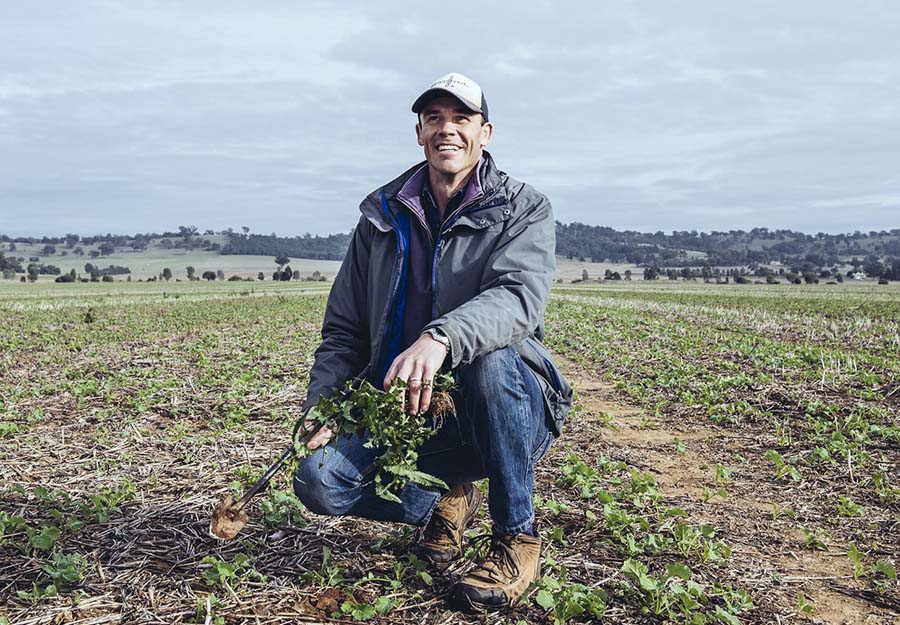The challenge
One of the greatest barriers to improving farm productivity in Australia is water. Not simply a lack of it or variations in the timing and intensity of rainfall events, but efficiently capturing, storing and converting every millimetre into plant biomass and grain yield.
CSIRO estimated that long term yields decreased by 1.1 per cent every year from 1990 to 2015 due to a reduction in rainfall and increase in heat (Hochman, Gobbett and Horan, 2017).
In simple terms, water use efficiency (WUE) is a measure of a crop’s capacity to convert water into yield using water stored in the soil and rainfall during the growing season. The amount of water used by a crop is usually defined as transpiration (from the leaves) plus evaporation (from the soil) although it’s also important to factor in water lost to the crop in run-off and drainage.
The response
Over the past ten years, GRDC research investments have established that water productivity (crop yield per unit of water used) increases of more than 40 per cent are possible by using improved pre-crop and in-crop management practices.
The background to some of these gains began in 2008, when GRDC started a five-year water use efficiency (WUE) Initiative (CSP00111) in collaboration with the CSIRO, challenging growers and researchers to lift the WUE of grain-based production systems by 10 per cent across Australia’s southern and western cropping regions.
The $17.6 million WUE initiative was one of the largest research projects ever undertaken in Australian agronomy. It built on the outcomes of multiple GRDC research investments and focussed on three core aspects: improving water capture, increasing soil water storage and lifting the conversion of stored soil moisture into crop productivity.

Greg Condon. Photo: WeedSmart
The WUE Initiative research clearly demonstrated the importance of pre-crop management to the WUE and yield of cropping systems. Pre-crop management includes practices that increase soil water capture and storage in the months and years leading up to sowing such as fallow weed management, rotation choice, long-term stubble retention and minimum tillage. These practices can contribute up to two-thirds of the WUE of grain systems.
Growers who successfully manage the pre-crop phase can then optimise the effectiveness of their in-crop management practices such as sowing date, nutrient, weed and disease management and capitalise on the increased soil water storage capacity.
The research found that optimal pre-crop and in-crop management in combination can deliver WUE gains in the order of 20-60 per cent, highlighting the importance of identifying profit drivers within a farming enterprise and prioritising management practices accordingly. This has the potential to significantly improve the long-term profitability of Australian farming systems.
With the WUE initiative’s results far exceeding the initial target of attaining a 10 per cent lift in WUE within Australian grain production systems, the research suggests that Australian grain growers have become the most advanced in the world for sustaining crop production in the face of declining rainfall.
The impact
GRDC analysis indicates growers in regions with an average 300 to 400mm of rainfall and yields of 2.56 tonne for wheat, 2.23 for barley and 1.37 t/ha for canola stand to benefit from this research.
In these regions an increase of 1 per cent in wheat, barley or canola yields is worth $7.97, $6.45 and $7.40 per hectare respectively.
Southern NSW agronomist Greg Condon has been involved with WUE research projects for more than 12 years and said the work had underpinned an evolution in the management of summer fallows and farming sequences in the region.
He said the depth and adoption of the project outcomes highlighted the value of long-term research investments.
“Protecting soil water is a real productivity driver and the work has enabled us to establish what management practices are and aren’t important to the profitability of our farming systems,” Mr Condon said.
“We’ve certainly started to see the benefits of the WUE research work in recent years. For instance, it’s been a game changer for growers who have managed summer weeds effectively and been able to grow a profitable crop on decile one or below rainfall.
“Many crops are dry sown in our region and the research work has given us the confidence to strengthen that practice, allowing earlier sowing opportunities which has a whole of farm benefit from both a productivity and profitability perspective.”

























































